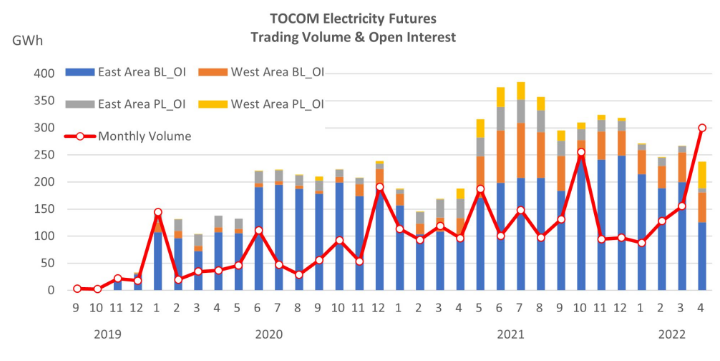TOCOM Energy
JPX Energy Market Updates(Jun. 6, 2022)
Crude oil futures were higher last week, with the JPX Dubai and other crude marker on track for an third straight week of gains, as the outlook for oil remained bullish with refined product inventories still tight and the north hemisphere about to start its summer driving season. There also has been a lot of turmoil in oil markets last week, with the EU banning Russian oil, OPEC accelerating its production increases, and U.S. inventories dropping once again. At the end of the week, sentiment is decidedly bullish amid improved demand outlooks following a robust US May jobs report. However, intermonth spread of major crude oil benchmarks seemed more hesitated to move forward further, price volatility is likely to remain high this week.
Earlier last week, EU members have finally agreed to a ban on Russian oil. EU officials have confirmed that the bloc’s Russian oil embargo will involve phasing out seaborne crude imports within six months and refined product imports in 8 months.
However, the agreement has been watered down quite a bit from the original proposal. Instead of targeting all Russian crude oil imports, the EU will ban imports of Russian seaborne crude oil,and approved a temporary exemption for crude shipments via pipeline for countries dependent on Russian supplies with no viable alternatives.
The pipeline derogation went additional than an preliminary compromise that advised Hungary, along with different landlocked international locations, could be allowed two additional years, till December 2024, to finish the embargo. This would ensure supply to landlocked countries in the Central Eastern Europe, which are very dependent on Russian pipeline supplies.
In theory, this should mean that around two-thirds of the roughly 2.3MMbbls/d of Russian crude oil imported will be affected. In practice, the volumes might fall even further because the largest recipients of oil from the Druzhba pipeline are Germany and Poland, and both countries have already said that they aim to reduce Russian imports to zero. So, the ban could target closer to 90% of Russian crude flows to the EU.
Besides, the European Union finalized its prohibition of financing and financial assistance services for Russian oil cargoes, a measure that is set to come into effect after a wind-down period of six months, effectively banning EU entities from providing insurance to Russian trade. Other insurance markets remain available for Russia oil exports, but the ban will further complicate the trade.
After holding broadly steady in March, Russian oil production plunged during April as the country’s refiners processed much less crude due to slower products exports and falling domestic demand in the wake of Western sanctions. According to an industry source, Russia’s crude oil and condensates production gained 5 percent to an average of 10.2 million bpd in May, which was down from 11.1 million bpd in February and 11 million bpd in March if confirmed by official data. The total amount of Russian oil lost to world markets is a moving target, as sanctions tighten and a lack of storage forces producers to shut in still more wells, a further loss of production is expected in the coming months.
On fears of falling Russian production, OPEC+ members agreed to raise their overall production targets by 648,000 b/d or about 50% higher than the typical 432,000 b/d monthly rise in both July and August, bringing the final unwinding of the oil group’s production cuts forward by one month.
Oil prices rose in response to the deal, while some of OPEC members have been struggling to hit their production targets in recent months due to lack of upstream investment or internal instability, Saudi Arabia and the United Arab Emirates are expected to be the main countries with enough spare capacity to compensate the shortcomings of other members. Both the Saudi Arabia and UAE has about 800,000 b/d of production upside that they can tap. Moreover, the fact that Russia was left in the group suggests that production from the alliance will continue to struggle to meet this increase in production quota.
On the demand side, tightness in the refined products market continues to prove supportive for crude oil prices, as healthy refinery margins should see refiners maximize their run rates. In Asia, the intermonth spread and crack spread for very low sulfur marine fuel oil soared to an all-time high. In the US, inventory draws were seen across the crude and refined products spectrum, in a sign of how summer demand continues to outstrip supply. Sweet and sour crude differentials remain supported by uptake to meet gasoline, diesel and jet demand requirements while reducing costs for energy and desulphurization.
It’s also worth noting that last week also marks the start of the Atlantic hurricane season as the first Atlantic tropical storm in the southern Gulf of Mexico was forecasted to have formed. Although it is believed that this storm will miss refinery row and have minor impact on oil and gas production in the Gulf, it is a reminder that hurricane season is here and this year any storm disruption will have a much bigger price impact on the back of very low inventories.






